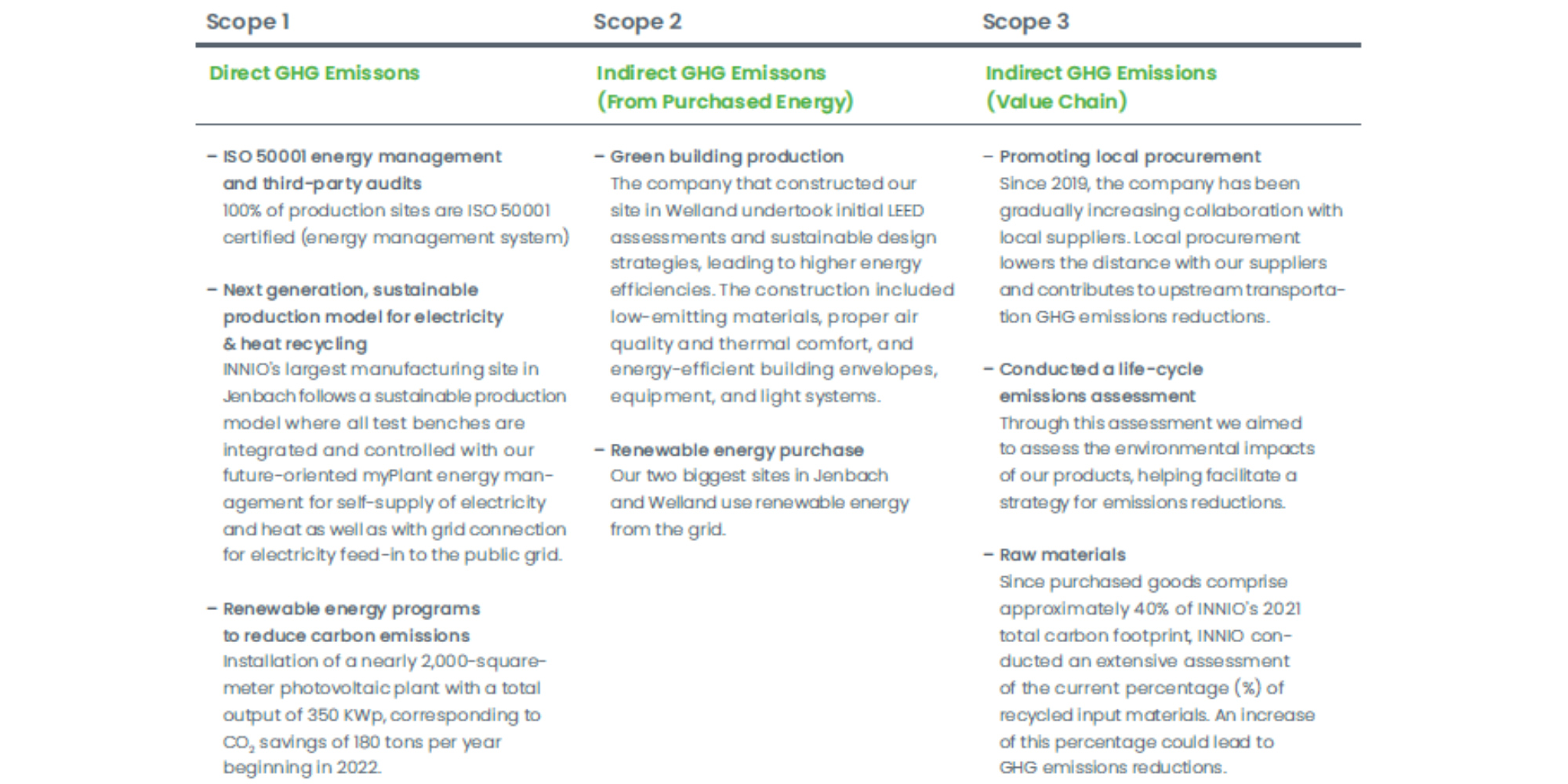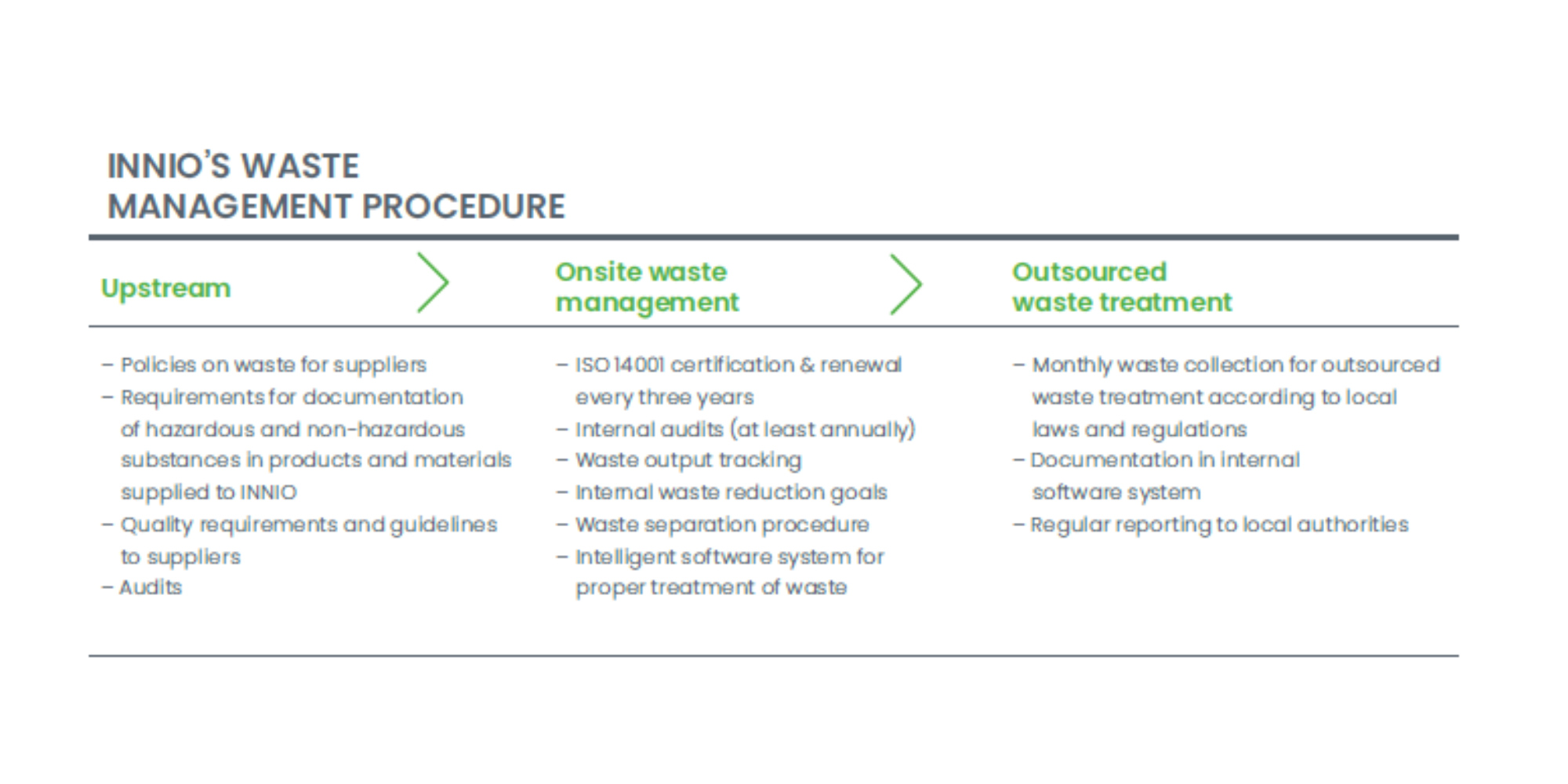Resilient supply chain & manufacturing
INNIO’s Integrated management system (IMS)
Our integrated management system combines standards, methods, and tools, and requires that all environmental-, health & safety-, quality-related activities (for our products and operations) to be consistent with national and international regulations and standards, including the ISO certifications.
To be more specific, INNIO’s IMS System requires that all our activities:
- Use energy responsibly and conserve primary energy resources
- Monitor, control and minimize greenhouse gas and air emissions
- Minimize wastewater and the impact of effluents on the environment
- Eliminate hazardous waste and significantly reduce our non-hazardous waste
- Increase the use of recycled, remanufacturable, or reclaimed materials
- Identify, manage, and minimize the effects to biodiversity
Our IMS system is ISO 14001, ISO 50001, ISO 9001, ISO 45001, and ISO 55001 certified. The certification is carried out by a third-party organization. Our certificate is based on a 3-year cycle, which means that we go through a re-certification every 3 years and in between we have so-called surveillance audits by the external certification company. The latest re-certification was completed during 2021.
INNIO’s dedicated Environment, Health & Safety (EHS) team, which is under the direct leadership of the VPs of Operations, is responsible for implementing the IMS System by monitoring and managing environmental and health & safety aspects, including energy use, carbon emissions, water use and discharge, the use of raw materials, waste management, biodiversity, and ecosystem protection, as well as EHS trainings and health & safety considerations. All INNIO facilities are required to review and update the environmental, health & safety and quality practices at least once per year and conduct internal audits that help determine possible gaps with respect to the system and internal and external standards.
Environment-related risks also are part of INNIO’s company-wide risk management system, while clearly defined risk policies and responsibilities across the company ensure the control and mitigation of these risks. INNIO tracks environmental performance in all relevant areas using a suite of indicators that are regularly validated, analyzed, and reported. Environmental awareness is promoted to the whole Group through various activities. All INNIO employees and contractors are required to complete annually our IMS-, Environmental-, and Occupational Health & Safety- trainings. Employees also are encouraged to provide suggestions that could improve INNIO’s EHS system in our INNIOvative platform. We select these suggestions for improvements submitted by employees or contractors and implement the most relevant. Additionally, all employees and contractors participate in regular awareness programs, workshops, online sessions, and emergency simulations such as building evacuation.
Environmental, Health & Safety (EHS) data regarding accidents, fatalities, near misses, energy consumption, waste generated, water and spills are reported through our Integrated Management System (IMS) based on submitted data from reporting entities within INNIO. Our IMS system ensures a comprehensive and consistent approach in handling environmental and health & safety aspects, and is validated via regular (at least annual) internal audits and online trainings.
Energy & Emissions
INNIO’s energy management system is part of the Integrated Management System and acts in accordance with ISO 50001. We monitor our energy consumption; we identify improvement areas and we set internal targets for the energy consumption of our sites and offices. We also aim to continuously increase the energy efficiency of our operations through technical improvements and process optimization. For many years now, our headquarters in Jenbach use an advanced energy management system in which all test benches are integrated and controlled with our myPlant energy management system for self-supply of electricity and heat. The thermal and electrical energy produced during the testing of our engines is fully utilized for the production process, while any surplus is provided to the communal heating network or the public grid. Furthermore, our Jenbach site uses a PV system that spans almost 2,000 m2 and recently we invested in a hydrogen network to supply green hydrogen for our test benches and engineering labs. Additionally, our site in Welland was constructed taking into consideration sustainable design strategies, including low-emitting materials, proper air quality and thermal comfort, and energy-efficient building envelopes, equipment, and lighting systems. Ninety-five percent of the electricity used at our facility in Welland is either renewable or climate neutral, coming from the hydro turbines at Niagara Falls. Furthermore, the factory’s initiative included the deployment of digital communication throughout the facility, reducing waste. These considerations enable our production site in Welland to use less and more efficient energy and reduce greenhouse gas emissions. All other sites and offices use an electricity mix from the grid.
We assess annually our GHG emissions according to the Greenhouse Gas Protocol, including all components of Scope 1, 3 and 3 emissions. These components are stationary combustion, purchased & consumed electricity, use of products, purchased goods, fuel indirect, upstream materials transportation, upstream leased assets, commuting to work, waste, downstream transportation, and business travel.
Our emissions reduction strategies are divided into three categories: Energy-efficient technologies and energy solutions, Responsible operations, and Resilient & low carbon supply chain. These strategies are being implemented by the respective departments as well as through extensive collaboration with relevant stakeholder groups (e.g., customers, suppliers, and employees).
Furthermore, we have committed to the Science Based Targets Initiative (SBTi), and we are currently working on setting the most ambitious, science-based emissions reduction targets possible. We also joined the Race to Zero initiative, a global campaign established by the UN Framework Convention on Climate Change (UNFCCC) to bring together global leadership for a healthy, resilient, and zero-carbon future.
INNIO’s GHG emissions reduction considerations

Water & Waste
INNIO’s water and waste management is covered by INNIO’s Integrated Management System (IMS) and is ISO 14001 certified. Dedicated experts from INNIO’s EHS team are responsible for monitoring and managing water and waste-related activities to help ensure that INNIO is fully compliant with applicable laws, regulations, and standards. Management approach, KPIs and goals are monitored and communicated regularly, at least quarterly, to the members of the Executive Board, who provide feedback. Together with all other environmental risks, water-related risks are also part of INNIO’s groupwide enterprise risk management process, while a systematic approach is taken into daily operations to measure, monitor and manage water-related activities. High-level water stress assessments are conducted on an annual basis. We use WRI’s Aqueduct Water Risk Atlas publicly available tool annually to assess water supply, effluent water quality, and regulatory/reputation risks. Results from these water risk assessments are used for assessing climate change-related water stress risk. We will continue to assess the water-related risks for our facilities and develop and implement water management plans. 100% of INNIO’s facilities are rated with low risk.
INNIO’s waste management strategies abide by the principle of waste generated minimization, resource recycling, reuse maximization, and waste disposal in an environmentally sound way, and is under the direct control of our IMS system. Our activities generate solid and liquid waste, including non-hazardous waste. A major part of our waste is non-hazardous, such as municipal waste, paper, and wood waste. Only a small fraction (less than 10%) of our waste is hazardous. Examples of hazardous waste include emulsion and alkali mixtures, waste oils, and waste from cleaning and specialty detergents. Our waste-related goals regard the elimination of hazardous waste and the recovery of more than 80% of non-hazardous waste.
Our Procurement team sets clear packaging and process guidelines for our suppliers. After raw materials are used in manufacturing processes, recycling or reuse is prioritized to help ensure that they are not immediately disposed of as waste. Our sites sort waste according to local municipal regulations. INNIO uses an internal software platform for documenting and monitoring the different types and weights of waste used as well as assessing their potential hazards. Finally, INNIO follows applicable local laws and regulations and regularly collects the waste for outsourced treatment. INNIO regularly reports about our waste management procedures to local authorities.

Supply chain management
Suppliers and business partners are an important and integral part of our business. For this reason, we aspire to foster strong, long-standing relationships with our suppliers to manage risk, and promote best practices throughout the supply chain. We expect our suppliers to conduct their businesses in compliance with the same high legal and ethical standards and business practices as ours.
INNIO’s sustainable supply chain approach, governed by the VP of Procurement and the dedicated Sustainability Procurement team, includes a dedicated ESG and Procurement Policy, a Supplier Code of Conduct, and a Conflict Minerals Policy through which we set clear guidelines and sustainability standards that we require our suppliers to follow. The dedicated Sustainability Procurement team is tasked with maintenance and development of operational frameworks, supply chain audits, contribution to the overall company-wide circularity process, as well as proactive sustainability and compliance-focused trainings.
Our supplier requirements regard areas of environmental and social performance, quality, occupational health and safety, human rights, anti-corruption, business ethics and compliance with local and international standards and legislations. INNIO’s environmental and social requirements are publicly available and regularly communicated to all existing and potential suppliers. Compliance with these requirements is assessed, both in the selection and onboarding of new suppliers, as well as in the continuous supplier performance management process.
The onboarding process for potential new suppliers considers the risks that the offering, location, and level of compliance with our supplier requirements pose. The general supplier requirements are also included in our standard supply agreements. Potential new suppliers must meet these requirements as well as sign that they follow the 10 Principles of the UN Global Compact in order to receive approved supplier status.
Supplier assessment
We work with suppliers, and we implement dedicated ESG assessments and audits for them. INNIO’s Procurement team sets clear internal and external ESG-related goals as well as a detailed ESG Procurement roadmap to achieve these goals. The supplier assessment comprises the following levels: a standard screening, a mandatory ‘vendor prescreen’ self-assessment, and an in-depth and onsite audit performed by INNIO’s Supplier Quality Engineer.
INNIO’s Procurement team performs advanced sustainability-related performance evaluations, included into the supplier scorecards. The sustainability section includes seven ESG criteria, representing 15 points (out of a total 100). The criteria include, among others: GHG reduction targets, certifications on environmental and energy management systems, the recycled material ratio in products sold to INNIO, and utilization percentage of renewable electricity in operations. For a supplier to be classified in “Class A” in the sustainability section of the scorecard, the supplier needs to score between 11 and 15 points. To score the maximum points (15) in the sustainability section, a supplier must set science based GHG reduction targets, use more than 75% of recycled materials, and have energy certifications in place.
Supplier rating
INNIO began a partnership with a third-party sustainability performance rating agency to assess the sustainability performance of INNIO’s top direct material suppliers. So far, this assessment has enabled us to gain a clearer sustainability standing of our suppliers, which is helpful in identifying key ESG issues and promoting an agile interaction with our suppliers and responsible business practices throughout the supply chain. Finally, the Sourcing team’s newest program requires a green building certification or energy class of “D” or better from all new and existing INNIO office space landlords. In this way, we ensure we only use and rent high energy efficiency performance.
/ Contact
Contact Us